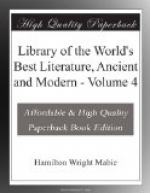Doth he smile? all frolic; doth he frown—all cower.
By a tone he threatens, gives rewards, metes justice.
Absent though he be, every pupil dreads him,
For he sees, hears, knows, everything that’s doing.
On the urchin’s forehead he can see it written.
He divines who laughs, idles, yawns, or chatters,
Who plays tricks on others, or in prayer-time’s lazy.
With its shoots, the birch-rod lying there beside him
Knows how all misdeeds in a trice are settled.
Surely by these traits you’ve our dorf-Dionysius!
[Footnote 17: Compare
Goldsmith’s famous portrait in
“The Deserted
Village".]
Translation through the German, in the meter of the original, by E. Irenaetis Stevenson, for the “World’s Best Literature”.
BION
(275 B.C.)
Of Bion, the second of the Sicilian idyllists, of whom Theocritus was the first and Moschus the third and last, but little knowledge and few remains exist. He was born near Smyrna, says Suidas; and from the elegy on his death, attributed to his pupil Moschus, we infer that he lived in Sicily and died there of poison. “Say that Bion the herdsman is dead,” says the threnody, appealing to the Sicilian muses, “and that song has died with Bion, and the Dorian minstrelsy hath perished.... Poison came, Bion, to thy mouth. What mortal so cruel as to mix poison for thee!” As Theocritus is also mentioned in the idyl, Bion is supposed to have been his contemporary, and to have flourished about 275 B. C.
Compared with Theocritus, his poetry is inferior in simplicity and naivete, and declines from the type which Theocritus had established for the out-door, open-field idyl. With Bion, bucolics first took on the air of the study. Although at first this art and affectation were rarely discernible, they finally led to the mold of brass in which for centuries Italian and English pastorals were cast, and later to the complete devitalizing which marks English pastoral poetry in the eighteenth century, with the one exception of Allan Ramsay’s “Gentle Shepherd”. Theocritus had sung with genuine feeling of trees and wandering winds, of flowers and the swift mountain stream. His poetry has atmosphere; it is vital with sunlight, color, and the beauty which is cool and calm and true. Although Bion’s poems possess elegance and sweetness, and abound in pleasing imagery, they lack the naturalness of the idyls of Theocritus. Reflection has crept into them; they are in fact love-songs, with here and there a tinge of philosophy,
The most famous as well as the most powerful and original of Bion’s poems remaining to us is the threnody upon Adonis. It was doubtless composed in honor of the rites with which Greek women celebrated certain Eastern festivals; for the worship of Adonis still lingered among them, mixed with certain Syrian customs.




